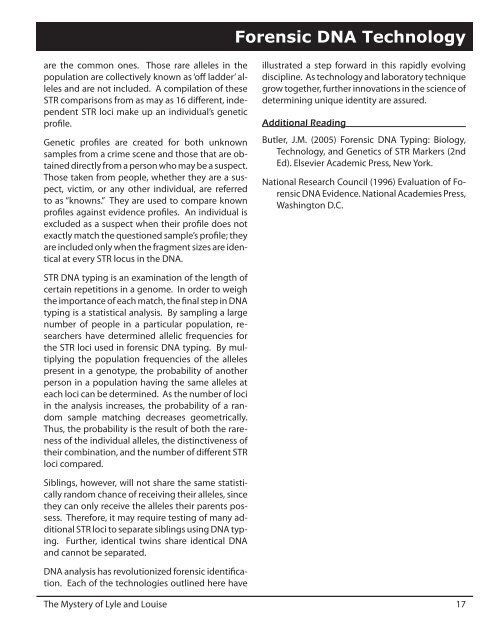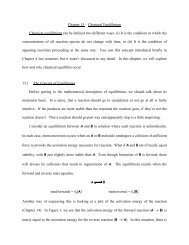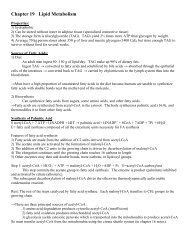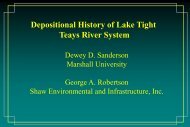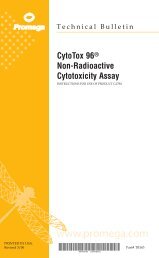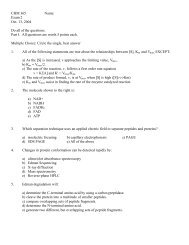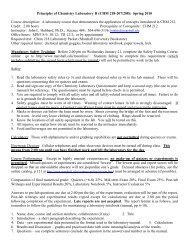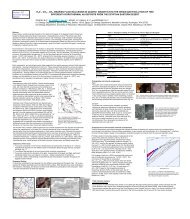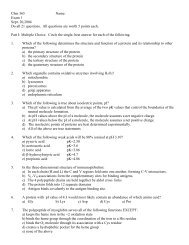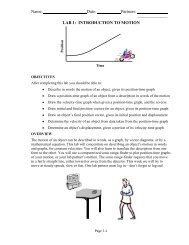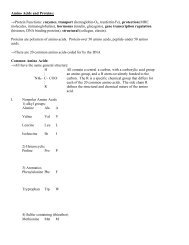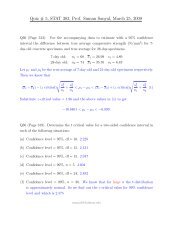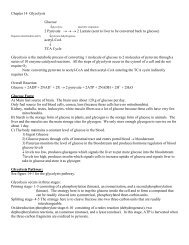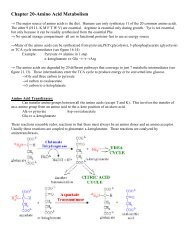Link to our lab as a pdf - College of Science - Marshall University
Link to our lab as a pdf - College of Science - Marshall University
Link to our lab as a pdf - College of Science - Marshall University
Create successful ePaper yourself
Turn your PDF publications into a flip-book with our unique Google optimized e-Paper software.
Forensic DNA Technology<br />
are the common ones. Those rare alleles in the<br />
population are collectively known <strong>as</strong> ‘<strong>of</strong>f ladder’ alleles<br />
and are not included. A compilation <strong>of</strong> these<br />
STR comparisons from <strong>as</strong> may <strong>as</strong> 16 different, independent<br />
STR loci make up an individual’s genetic<br />
pr<strong>of</strong>ile.<br />
Genetic pr<strong>of</strong>iles are created for both unknown<br />
samples from a crime scene and those that are obtained<br />
directly from a person who may be a suspect.<br />
Those taken from people, whether they are a suspect,<br />
victim, or any other individual, are referred<br />
<strong>to</strong> <strong>as</strong> “knowns.” They are used <strong>to</strong> compare known<br />
pr<strong>of</strong>iles against evidence pr<strong>of</strong>iles. An individual is<br />
excluded <strong>as</strong> a suspect when their pr<strong>of</strong>ile does not<br />
exactly match the questioned sample’s pr<strong>of</strong>ile; they<br />
are included only when the fragment sizes are identical<br />
at every STR locus in the DNA.<br />
illustrated a step forward in this rapidly evolving<br />
discipline. As technology and <strong>lab</strong>ora<strong>to</strong>ry technique<br />
grow <strong>to</strong>gether, further innovations in the science <strong>of</strong><br />
determining unique identity are <strong>as</strong>sured.<br />
Additional Reading<br />
Butler, J.M. (2005) Forensic DNA Typing: Biology,<br />
Technology, and Genetics <strong>of</strong> STR Markers (2nd<br />
Ed). Elsevier Academic Press, New York.<br />
National Research Council (1996) Evaluation <strong>of</strong> Forensic<br />
DNA Evidence. National Academies Press,<br />
W<strong>as</strong>hing<strong>to</strong>n D.C.<br />
STR DNA typing is an examination <strong>of</strong> the length <strong>of</strong><br />
certain repetitions in a genome. In order <strong>to</strong> weigh<br />
the importance <strong>of</strong> each match, the final step in DNA<br />
typing is a statistical analysis. By sampling a large<br />
number <strong>of</strong> people in a particular population, researchers<br />
have determined allelic frequencies for<br />
the STR loci used in forensic DNA typing. By multiplying<br />
the population frequencies <strong>of</strong> the alleles<br />
present in a genotype, the probability <strong>of</strong> another<br />
person in a population having the same alleles at<br />
each loci can be determined. As the number <strong>of</strong> loci<br />
in the analysis incre<strong>as</strong>es, the probability <strong>of</strong> a random<br />
sample matching decre<strong>as</strong>es geometrically.<br />
Thus, the probability is the result <strong>of</strong> both the rareness<br />
<strong>of</strong> the individual alleles, the distinctiveness <strong>of</strong><br />
their combination, and the number <strong>of</strong> different STR<br />
loci compared.<br />
Siblings, however, will not share the same statistically<br />
random chance <strong>of</strong> receiving their alleles, since<br />
they can only receive the alleles their parents possess.<br />
Therefore, it may require testing <strong>of</strong> many additional<br />
STR loci <strong>to</strong> separate siblings using DNA typing.<br />
Further, identical twins share identical DNA<br />
and cannot be separated.<br />
DNA analysis h<strong>as</strong> revolutionized forensic identification.<br />
Each <strong>of</strong> the technologies outlined here have<br />
The Mystery <strong>of</strong> Lyle and Louise 17


